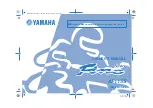
- 46 -
PAL Dynastarter
Details of design: the dynastart parts are similar to those in the 6V 45W
dynamo. The rotor is provided with a winding, the outlets of which are soldered to the
individual commutator plates. Inside the rotor there is a tapered opening for fitting on
to the crank pin. On the outer side /at the commutator/ the opening is provided with a
thread for the screwing on of the puller. The dynastart stator has four pole shoes
each of which is provided with a double winding. The first winding is made of copper
wire and serves as field winding when the engine is running, and for the operation of
the dynastart as electric current source. The second current winding, made of copper
strips, serves to excite the stator when operating as electric starter. The field coils of
both kinds of windings are series connected, one end of both windings being
connected to the frame, the second end of each winding being connected separately
to a terminal. The winding for starting to the terminal marked S /starter/, the winding
for stator exciting with the engine running to the terminal marked D /dynamo/.
Both the size and the windings of the dynastart / rotor as well as stator are
well dimensioned and ensure reliable operation.
On the dynastart stator are located four holders for the carbon brushes, two of
which operate the dynamo and the other two operate the starter. The terminals of
two of the carbon brushes connect to the stator frame. The base plate with contact
breaker and condenser on the stator face serves as ignition circuit contact breaker.
PAL 12V Regulator With Contactor
- Fig. 29
The regulator with contactor is on a common plate and is protected by a
cover. The regulator itself is mechanically identical to the PAL 6V regulator employed
on motorcycles and scooters equipped with the 6V 45W Jawa dynamo. The
difference is that both the voltage and current coil winding is adapted to 12V volts as
well as the higher output required to operate the dynastart. Another difference is that
the regulator leads are connected to the terminal base. The contactor, which
switches the current onto the starter, is located on the same plate as the regulator.
The primary current /switch/ circuit leads the current from the switch box with the
–
START - position to terminal 50 and then via the switch coil to the frame. The iron
core has above it the toggle lever shaped armature, the bottom end of the toggle
lever functioning as the contactor contact and with the armature attracted to the core,
connects the electric starter current circuit.
Summary of Contents for 501/01
Page 1: ...orkshop anual This manual covers all Cezeta and N Zeta models M W ...
Page 12: ... 11 Fig 2 ...
Page 20: ... 19 Fig 7 ...







































